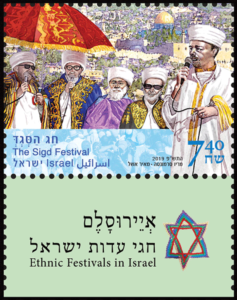Ethnic Festivals in Israel: The Sigd Festival
Issue Date: November 26
 When the State of Israel was founded and its gates were opened to Jews from around the world, the wave of Olim (new immigrants) which had been rising since the end of the 19th century became a virtual flood. Entire communities from around the globe gathered their belongings and made their way to the Land of their ancestors. Each community brought its customary garb, special language, traditions and all of the other cultural components it had developed over centuries in the Diaspora.
When the State of Israel was founded and its gates were opened to Jews from around the world, the wave of Olim (new immigrants) which had been rising since the end of the 19th century became a virtual flood. Entire communities from around the globe gathered their belongings and made their way to the Land of their ancestors. Each community brought its customary garb, special language, traditions and all of the other cultural components it had developed over centuries in the Diaspora.
In the early years of the State, Israel’s leaders had to cope with the huge challenge of formulating a new society, one that would incorporate people from Jewish communities around the globe. As part of the “melting pot” concept the new immigrants were expected to abandon the traditions they brought from their native lands and embrace the image and traditions of the new Israeli. This attitude changed over the years and was replaced by one that honored and cherished the immense cultural wealth brought by the Olim. Israeli cuisine adopted diverse flavors and foods originating around the world, Israeli music enriched its work with a broad range of tones and the Israeli calendar integrated holidays and festivals celebrated by the different ethnic groups. Some of these festivals have spread beyond their original ethnicity and are celebrated by Israeli society as a whole.
The Sigd Festival
The Sigd Festival is unique to Ethiopian Jewry and is celebrated each year on the Hebrew date of 29th Heshvan, 50 days after Yom Kippur. In addition to the name Sigd (which stems from the Hebrew word Sgida, meaning worship) it is also called the “festival of supplication” and the “annual gathering”. It is a day of fasting and purification, including a ceremony to renew the covenant between the people and God and a prayer to return to Jerusalem.
The Sigd ceremony is based on the detailed description of the renewal of the covenant conducted in Jerusalem by Ezra and Nehemiah upon the return to Zion (Nehemiah chapters 8-10). It was customary in Ethiopia to hold the ceremony atop a high mountain, symbolizing Mount Sinai. On the eve of the festival, participants would gather at the foot of the mountain selected for the ceremony and purify themselves. Early in the morning they prepared food that would be served at the end of the fast day. On the morning of the Sigd, participants gathered dressed in their best clothes and ascended the mountain together, carrying the Ethiopian Torah (Orit). At the summit of the mountain, the Kess (priests) led prayers praising God, expressing repentance, requesting forgiveness and longing for Jerusalem. They read the Ten Commandments, chapter 9 from the Book of Nehemiah, blessings and curses to the gathered worshippers. At the end of the ceremony, the participants confessed their sins and expressed their desire to celebrate the following year in Jerusalem. The journey back down the mountain was joyous, filled with singing and dancing, and the day concluded with a banquet to break the fast.
When the Jews of Ethiopia made Aliyah to Israel, it was decided that the Sigd would continue to be celebrated annually in Jerusalem. The Sherover Promenade in Jerusalem, which overlooks the Temple Mount, was chosen as the site for the event and it is there that the members of the Ethiopian community gather. In addition to the prayer ceremony conducted by the Kess priests, the festive gathering itself is considered to be significant.
Description of the Stamp
• Background photo of Jerusalem, photo of the Kess priests and photo of the participants celebrating: Gidon Agaza.
• Photo of the Star of David on the stamp tab – courtesy of Elmaz Art in Israel.
• With thanks to the Association of Ethiopian Jews for their help in preparing the stamp and the text. This is the third in a series of three stamps, including those featuring the Sehrane and Mimouna festivals, which were issued earlier this year.
Technical Specifications:
Size of stamps: W: 40 mm, H: 30 mm
Face Value: NIS 7.40
Plate Block No.: 1140
Designer: Mario Sermoneta & Meir Eshel
Printing Method: Offset
Printer: Enschede, Netherland
Sheet Type: Regular
Stamps per sheet: 15
Tabs: 5
No. of FDC’s: 1
Price of FDC’s: NIS 8.60
Place of cancellation: Jerusalem



